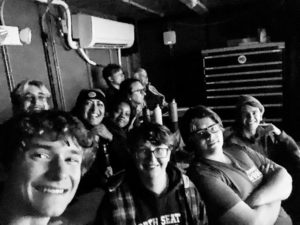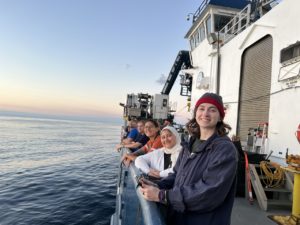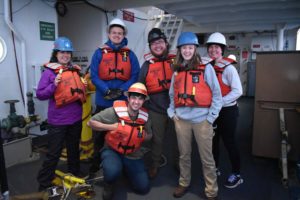On August 11, we closed out another highly successful Regional Cabled Array cruise with the completion of all core Ocean Observatories Initiative and externally funded PI tasks scheduled for the annual maintenance and operations expedition. This was also one of the most successful years for the at-sea experiential VISIONS program with an amazing and diverse cohort of students. Many of the students shared that this experience changed their lives. After record setting days of operations during the 37-day expedition, many of the team members have taken some well-deserved time off. During our time on the ocean, somehow the season changed to fall and it’s a bit shocking to come back to the hustle and bustle on campus with classes starting this week at the UW – where did the summer go?
This was an amazing field season. Over the 8 days of mobilization and demobilization on the R/V Atlantis, nineteen 48-ft trailers moved 354,716 lbs of RCA equipment to and from Seattle, WA and Newport, OR to the logistics facility and onto/off the ship. The RCA Logistics team provided 45 days of shore support. Onboard staffing during the three legs included 68 personnel with 8 RCA science and 13 engineering staff members, 24 undergraduate students, 2 Ph.D. students and two external PI’s (researchers) from Carleton College and the University of Maryland. During 27 days at sea, there were 68 Jason Dives – a record for the ROV. The Jason team was highly efficient in installation and recovery of instruments/infrastructure – the vehicle carried 82,000 lbs of gear to and from the seafloor! The team was also very supportive of the VISIONS students in the control room and provided important learning experiences, including letting few lucky students pilot the ROV.
The RCA team gives a big shout out to both Jason and the Atlantis for their excellent support and to contributing to this highly successful cruise.
Other highlights from the cruise include:
- Turning of 7 platforms on the Shallow Profiler Moorings
- Turning of 2 Benthic Experiment Packages and 4 secondary Junction Boxes
- Turning of 3 Deep Profiler Vehicles and cleaning of cables
- Installation and recovery of 130 RCA instruments
- Installation of 1 discrete temperature probe (HOBO)
- 140 RCA instruments are operational, as well as all 6 cabled PI instruments
- All Shallow and Deep Profiler vehicles are conducting their missions
We were proud to support 7 days of externally NSF-funded programs to investigators outside of the RCA team. It was a pleasure to sail with Dr. Rika Anderson from Carleton College and Dr. Laura Lapham from the University of Maryland. Anderson, using the Universal Fluid Obtainer, continued her time-series characterization of microbes and viruses at Axial Seamount. Lapham, recovered four osmotic fluid samplers at Southern Hydrate Ridge, collected 30 push cores and biological and Niskin samples as part of her study on carbon in the highly dynamic seeps sites. Both PI’s were highly supportive of the VISIONS ‘students and entrained them in their research. Anderson’s program provided a wonderful gift to all onboard as we were able to visit the CASM and Dymond hydrothermal fields in search of sampling sites. Both hosted astoundingly beautiful hydrothermal vents. Dymond was particularly amazing as we had only visited it once years before after its discovery on VISIONS’11. It is a highly anomalous field because it is located near the base of Axial Seamount and hosts crazy-looking chimneys on 30-60 m tall chimneys covered in vast areas of orange-colored bacteria free of the tubeworm communities. Localized areas with similar biology as on the summit of Axial are interspersed. Anderson was able to sample one of the sites we found in 2011 and we collected corresponding fluid-gas samples. We are very curious about here results.
Other work included installation of a novel self-calibrating pressure sensor at the summit of Axial Seamount through an NSF award to Dr. William Wilcock (UW). This instrument will continue Wilcock’s time-series investigation of deformation in the caldera of Axial Seamount in response to build up of melt in the underlying magma chamber and eruptive events. In 2026, as part of a large award to Wilcock, several of these instruments will be installed along a cabled transect off Newport OR to measure deformation in, what is thought to be, the only ‘unlocked’ portion of the Cascadia Subduction Zone.
PI instrumentation that was installed this year within Axial Caldera included four CTD’s through an NSF award to Dr. William Chadwick (Oregon State University), to test the hypothesis that warm, dense brines are expelled from the seafloor associated with seafloor eruptions. In addition, four stand-alone battery powered temperature probes were installed in the throats of high temperature black smokers in the ASHES, International District and Coquille hydrothermal fields as part of an NSF program funded to Drs. Guangyu Xu (UW), Dax Soule (Queens College) and Chadwick to continue time-series investigation of process linkages among seafloor deformation and crustal hydrogeology.
We had a remarkable cohort of VISIONS’24 students who were a delight to have onboard. Their energy and excitement permeated the ship. Twenty-four undergraduate students and 2 graduate students participated in the at-sea experiential learning program over the 3 Legs. They included students of highly diverse gender, educational, and economic status from the US, Korea, Saudi Arabia, and France. The students represent a breadth of disciplines spanning Oceanography, Engineering, Marine Biology, Earth and Space Sciences, Applied Math, Computer Science, and Human-Centered Design and Engineering. Three summer REU students working on RCA data participated on the cruise, gaining direct field experience on instruments and data collection that they had worked on over the summer. All students stood 4 hr on, 8 hr off watches in the Jason control van, helped with deck work and collection and sampling of CTD fluids, learned about ship operations, and contributed student blogs on the Interactiveoceans website. It was wonderful to see the operations, and ocean landscape and amazing biology through their ‘new’ eyes and watch them gain confidence in the ROV control room and deck operations.
We much look forward to working with thirteen UW undergraduate students this fall and a few on the east coast who will continue research-engagement projects, with some extending for 1 to multiple years. RCA data will be the focus of at least five Senior Thesis projects this year in geophysics, geology, computer sciences, and marine biology.

Control van filled with Erik, Emily, Nikola, Nic, Finn, Atticus, Makayla, Joe, Alex, Deb, and Katie. Leg 1. Credit: E. Perkins, University of Washington, V24

Brown-yellow iron-oxide colored spires (left) bound biological habitats similar to those at the summit of Axial Seamount. Credit: UW/NSF-OOI/WHOI; J2-1668, V24.

Students, engineers, and scientists gathered on the starboard side of the Atlantis to watch a glorious sunset on the last full day of VISIONS’24 Leg 2. Credit: M. Vardaro, University of Washington, V24.

Students, RCA Tech, and I watching the CTD last night. Credit: M. Elend, University of Washington; V24.
Recent Updates